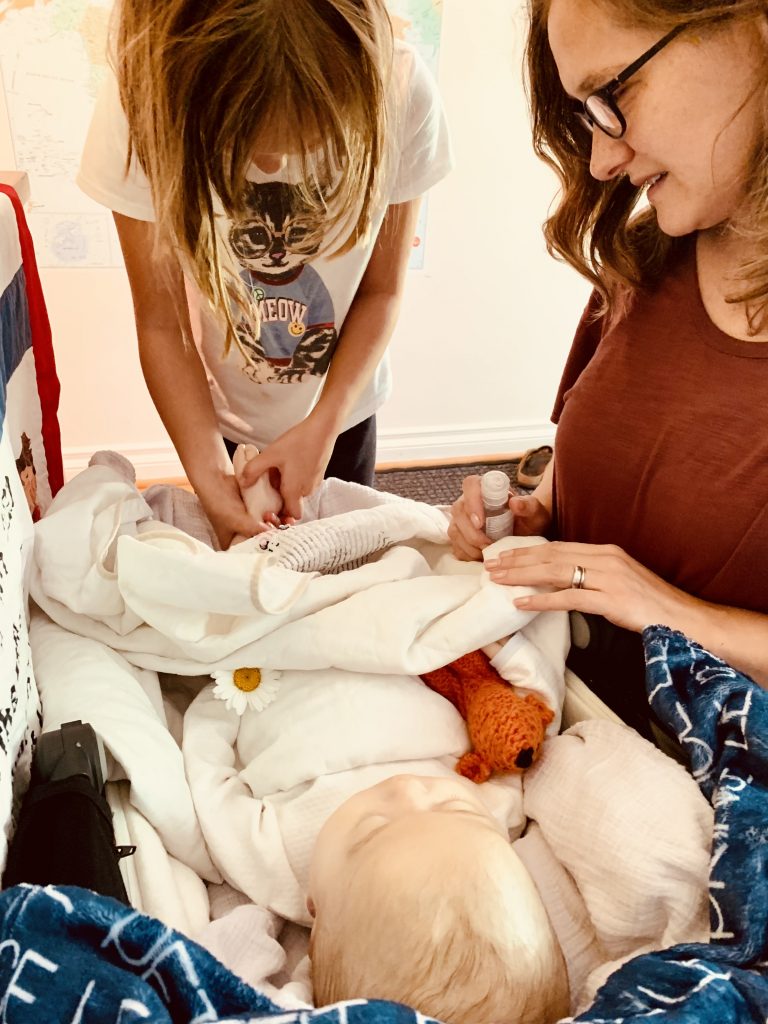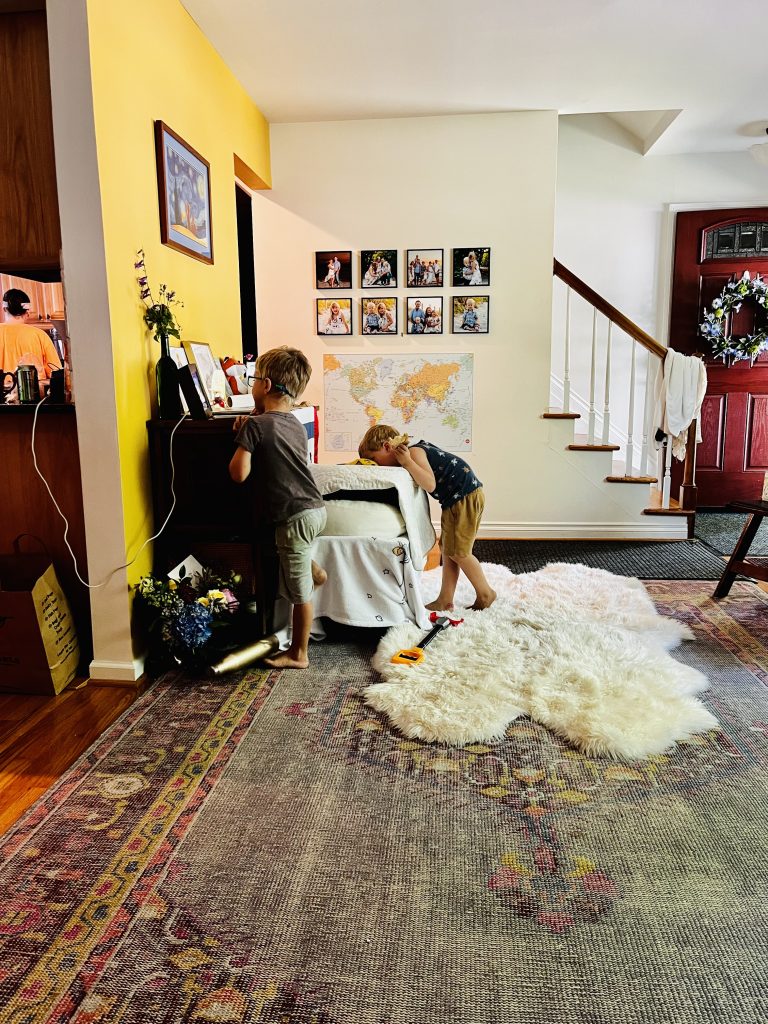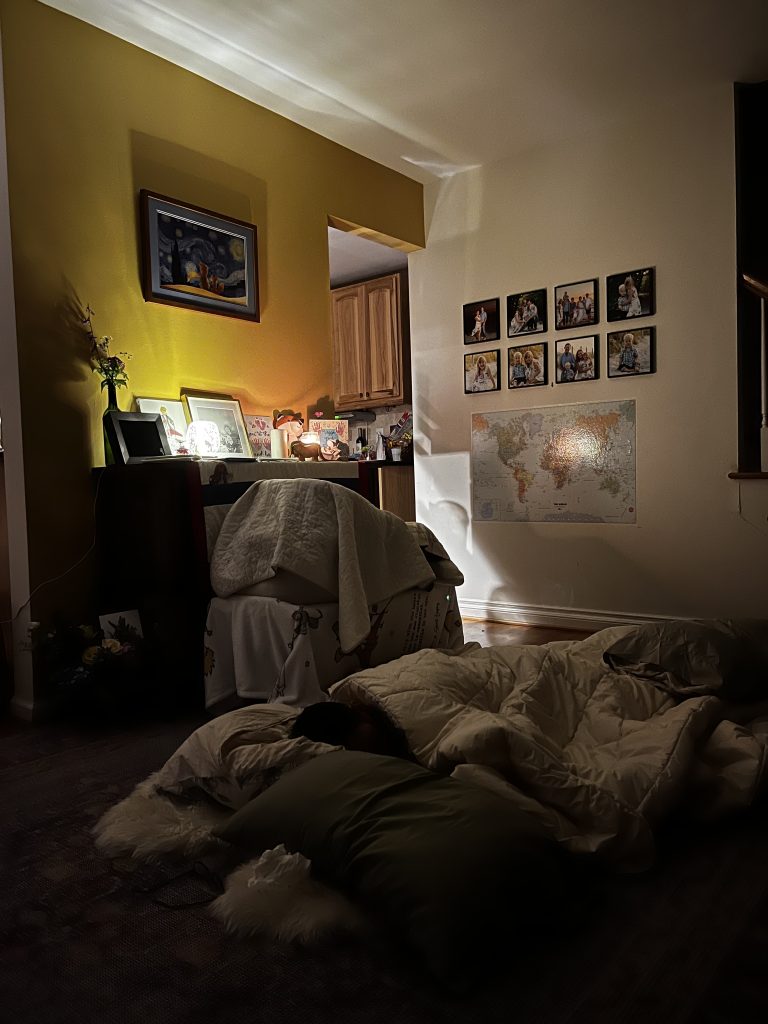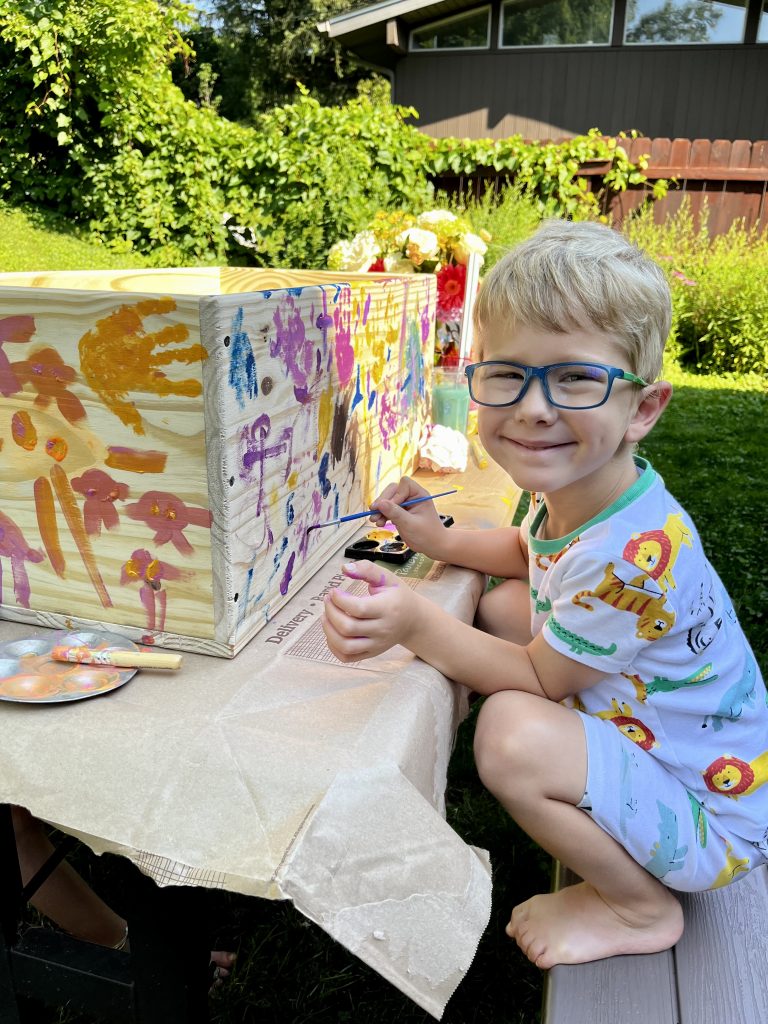Advisory: This blog piece is an intimate description Viggo's home funeral. It contains imagery that may be difficult to read and see.
When our third child Viggo was born early via emergency c-section, his dad accompanied him to “the nest” where neonatologists immediately hooked him up to CPAP and leads to monitor his vitals. Theron stayed with Viggo until he was safely tucked into his NICU isolette, when he finally slipped away just long enough to find me in my hospital room and wheel me down to see our newborn. From those first moments onward, we hovered around our son, leaving only to sleep. We learned to do all of his care, how to administer his medicines and navigate the machines and treatments he needed hour by hour, minute by minute. When he had surgery, we accompanied him as far as we were allowed, then waited just outside in the OR waiting room. When Viggo was admitted to the PICU, we took turns sleeping in his room. We never left him.
This level of attachment came naturally. Yet, within hours of his eventual death, we were expected to let strangers come and take his body away.
It wasn’t always this way. And we learned, through the involvement of our son’s end-of-life doula, that it doesn’t have to be this way.
Our son’s home funeral was not a long-planned or well-orchestrated event. We don’t come from a cultural or religious tradition that has a playbook for such things. Rather, it arose organically because we were given the permission to follow our instincts after he died.
Viggo died suddenly and unexpectedly after being discharged from the PICU on the upswing from a respiratory infection. While he had been in hospice care due to complications related to his genetic condition, and while we had thought about how we wanted to show up for him when the hour of his death drew near, we had a mental block with regard to what would come after.
Fortunately, we had a well-trained pediatric end-of-life doula in our corner. A bereaved mom herself, she offers doula services to families on a completely volunteer basis. After a harrowing rush to the ER and after Viggo was stabilized back in the PICU, I texted her. It was the middle of the night, but she answered right away. I felt silly; he was stable now. I didn’t like contacting her and I never had for any of our previous hospital admissions or medical issues. I guess there was a part of me that felt this time was different, even though most of me was trying to find my equilibrium and settle in for another long hospital stay.
A few hours later, I texted her again. Viggo had taken a turn for the worse and could not be stabilized. He was dying. She appeared after Theron and I had moved with our son to the “transition room” on the PICU floor. He died quickly and peacefully in our arms.
 My memories that morning of anything besides Viggo are hazy, but I remember her appearing briefly in the foreground to say something very practical and necessary, and then fading out of view again. For example, after he died, there was a period of intense emotion in the room. The doctor came in to pronounce his time of death: 6:17am. At some point we started to lift our heads, and that is when she told me I could change his diaper. She explained some of the changes his body would start to undergo; discoloration around his bottom where blood was pooling under the skin, and stiffness. She told us to arrange his body in a way that we would want him to be before the stiffness set in. After a while she brought us ice packs and explained how to keep him cool. She gave us baby oil to keep his skin moist. She said we could bathe him in lukewarm water if we liked.
My memories that morning of anything besides Viggo are hazy, but I remember her appearing briefly in the foreground to say something very practical and necessary, and then fading out of view again. For example, after he died, there was a period of intense emotion in the room. The doctor came in to pronounce his time of death: 6:17am. At some point we started to lift our heads, and that is when she told me I could change his diaper. She explained some of the changes his body would start to undergo; discoloration around his bottom where blood was pooling under the skin, and stiffness. She told us to arrange his body in a way that we would want him to be before the stiffness set in. After a while she brought us ice packs and explained how to keep him cool. She gave us baby oil to keep his skin moist. She said we could bathe him in lukewarm water if we liked.
It is hard to describe in words how I was feeling in those moments. Out of body. Shaken. Bereft. Afraid. UNSURE—about how his body might change, what might happen to it, how it would look and feel. It was not unlike how I first felt in the NICU with his fragile, premature, post-operative body. Caring for him in that context did not come naturally. I needed the encouragement of the NICU nurses. They showed me how, and eventually I became a pro.
In the same way, our doula demystified how to care for Viggo’s body now that he had passed. She was extremely calm and matter-of-fact about it, which diffused some of my fear and discomfort. She also told us the options we had: bring our baby home or have his body taken to a funeral home.
We had never seen a “home funeral” before. Neither had anyone in our family or community. All I knew in that moment–with every fiber of my being–was that our baby’s body belonged AT HOME, WITH US. I did not want a stranger touching him. I did not want him to go to the morgue. I did not want him to be stored overnight in a strange place, all alone. I did not want to be separated from his body.
This didn’t feel like a preference. This felt like an IMPERATIVE. Viggo was inside me only a few short months ago. We had never been physically separated for more than a few hours. His father and I were his caregivers. Why simply because he died should we stop being the ones to care for his body?
We could not go from 24/7 to zero just like that. Being forced to do so would have added to our trauma.
I am aware that most parents are never given this option. In fact, it almost wasn’t an option for us. Our local funeral home does not support home funerals. Funeral directors are legally responsible for the bodies that come into their care from the morgue. Each transfer requires paperwork. Death workers have licenses and there are rules that apply. The funeral director must ensure the body’s integrity and final disposition in a manner that complies with the law.
Intellectually and as a lawyer, I understand the overriding interests of the state in accounting for dead bodies. As a mother, however, it was unthinkable to me that just because my baby died, I legally lost custody of him. Fortunately, our doula knew a funeral director who was willing to allow bodies in his care to be kept in the family home. While Theron and I drove home to wake up Viggo’s big sister and brother and tell them the news, she coordinated with the funeral director.
Just as we always had accompanied him in life, we wanted to take Viggo out of the hospital ourselves. This proved to be an even bigger challenge, because our children’s hospital does not have protocols in place to allow a family to accompany their child’s body out the door or drive them home. The hospital requires a surrender to the morgue, then the morgue gives the body to the funeral director. While we could not get clearance to take him out of any reasonable door under a blanket in his stroller, we were able to accompany him to the morgue, where we met the funeral director.
I remember putting Viggo in his carseat, his stiffening body not fitting in it as well as when he was alive. I fumbled for the buckles and Theron gently reminded me that wouldn’t be necessary. I spoke to Viggo as I did this, the same way I always did. “Mommy’s going to put you in the car seat now, sweet boy. There you go, my love. . .” This all came so naturally. It needed to come, to be expressed. I had to walk through these rituals of life, now in death, for my mind and body to begin to make the shift from mother to bereaved mother.
I remember standing outside the morgue, deep in the bowels of the hospital and just inside a giant loading dock, as the morgue worker demanded to see Viggo’s ID bracelet. It had been removed at some point apparently, which was a problem. His nurse was with us, and assured the morgue worker of the name of his patient. There were signatures on a form, but not parent signatures. We were not part of the chain of custody.
We met the funeral director for the first time right there in the loading dock, at the door of the morgue. I remember when he took Viggo from us, still tucked in his carseat. He acted with such compassion and care. He said, “I will take good care of him and I’ll be at your house when you get there.”
It was so, so difficult to hand Viggo’s body over to the funeral director in that moment. While I couldn’t change the fact that he was dead, I was not ready to be separated from him yet. What is more, this kind man was a stranger. No parent hands their baby off to someone they just met. It goes against all our instincts.
But I was soothed by the funeral director’s manner. I was soothed because I knew we would be reunited with him in just a few minutes at our home. I would not have been OK if he had been taken from me under any other circumstances. Walking back to our car with an empty stroller, I felt deeply hollow and deeply heavy at the same time.
As we drove home, our eight-year-old daughter asked, “What am I going to tell my friends when they ask about Viggo?” She was wrapping her mind around having to answer a question that big. She was also feeling very alone in her experience, not sure what role her community would play next. We assured her that all of her friends would already know, and that they would be there to support her. This gave us some insight into the importance for our children of their friends’ participation in funeral rituals.
The funeral director was waiting for us outside our house when we got there. Our neighbors were also there; they had already cleaned up the house, brought food, and arranged flowers. The funeral director gave us simple instructions: keep his body cold by tucking dry ice under his torso; keep his skin moisturized with baby oil; take all the time you need. He assured us that Viggo’s body would be fine for several days. He gave us his cell phone number and told us to call if we wanted or needed anything.
We set up a small place for Viggo in the living room. We laid him in his bassinet, and a neighbor brought a perfectly-sized coffee table to place the bassinet on. A sideboard behind his bassinet served as a memorial table, covered with photos and special items. The low height of the coffee table invited adults who visited to kneel or sit on the floor or a chair. Children could simply walk in and look at Viggo without the assistance of an adult.
I have photos of our daughter taken about 24 hours apart: on July 17, she was singing to her baby brother and stroking his head as he slept in his crib. On July 18, she was caring for his deceased body by rubbing oil on his legs and feet. For me, these photos illustrate why caring for Viggo’s body at home was the right thing for our family. The home funeral provided a venue for continuity in caregiving from life to death. It allowed us to express our love in connection with his physical body and to slowly, on our own timeline, begin to separate from his physical form.
 Our neighborhood is full of children and families who have become like family to us. On regular summer days, the kids run from backyard to backyard until they are called in for dinner. During Viggo’s life, our older children’s friends formed relationships with him; they interacted with him, held him, pushed him in his stroller, prayed for him, and kept abreast of his medical status along with their parents. He was well-loved. It was important that these children participate in Viggo’s death on their own terms.
Our neighborhood is full of children and families who have become like family to us. On regular summer days, the kids run from backyard to backyard until they are called in for dinner. During Viggo’s life, our older children’s friends formed relationships with him; they interacted with him, held him, pushed him in his stroller, prayed for him, and kept abreast of his medical status along with their parents. He was well-loved. It was important that these children participate in Viggo’s death on their own terms.
None of the families who showed up at Viggo’s home funeral knew how this experience was going to land for their kids. Neither did we. A lot of parents fret about the hassle of taking kids to funeral homes, and the potential negative impact of letting them see dead bodies. Yet somehow, a mere six hours after Viggo died, his body was lovingly laid out in our living room at child-height. On one hand, it was uncharted waters. On the other hand, it felt like the most natural thing in the world.
The children didn’t have a lot of preconceived notions about what funerals are or should be. We adults took our cues from them. Because we were at home, the children had the freedom to come and go, interact or stay away.
They gathered flowers and brought them inside to lay on Viggo’s body. They touched him, kissed him. They cried. They went outside and played. They drew a picture for him and placed it near his body. They asked questions. They went back outside and played. They got hungry and ate. They played. They came back to visit Viggo’s body. In and out. Back and forth. Play and grief.
At one point on the second day, I was alone with Viggo and had moved to a couch on the far side of the room. I watched in amazement as my son and nephew (Viggo’s brother and cousin), both four years old, came in from outside, unaware of my presence. My nephew was eating a peanut butter and jelly sandwich. The boys approached Viggo’s body, gesturing and talking about some of the photos that were rotating through on the digital frame behind Viggo. Then my nephew leaned over and, still clutching his sandwich in one hand, kissed his baby cousin’s forehead. A few minutes later, they wandered back outside again.
Not a single child who participated in Viggo’s home funeral was traumatized by seeing his body. None had nightmares. None have even expressed any unusual fears about death and dying.
What is good for the children is good for the adults.
 Like the kids, my husband and I could take breaks as needed. There was always an adult in the room, holding vigil over Viggo’s body. We could go and hide in our bedroom when we needed privacy. We wore comfortable clothes. We ate when we were hungry, from our own kitchen. We didn’t have to go anywhere or follow a schedule to be with our son. We didn’t have to stand next to a casket and greet people paying their respects for two hours straight while trying to make sure our older kids’ needs were met. The house and yard were full of family and friends who looked after our big kids and took care of absolutely everything else so that we could focus on our baby. (They even landscaped the yard!)
Like the kids, my husband and I could take breaks as needed. There was always an adult in the room, holding vigil over Viggo’s body. We could go and hide in our bedroom when we needed privacy. We wore comfortable clothes. We ate when we were hungry, from our own kitchen. We didn’t have to go anywhere or follow a schedule to be with our son. We didn’t have to stand next to a casket and greet people paying their respects for two hours straight while trying to make sure our older kids’ needs were met. The house and yard were full of family and friends who looked after our big kids and took care of absolutely everything else so that we could focus on our baby. (They even landscaped the yard!)
Theron and I slept next to Viggo on the floor the first night. The second night, we brought him into our bed and read him books one last time. We kept his body at home with us for two days and two nights.
As the hours wore on, we observed subtle changes in Viggo’s body. These changes allowed the reality of death to slowly sink in. On the morning that we planned to drive Viggo to the crematory, we had an intimate, family-only ceremony with our minister in our living room. At this point, we as parents had a deeply-felt sense that it was time to say goodbye to Viggo’s physical form.
 Theron and I carried Viggo’s hand-made and hand-painted box into the crematory ourselves. After we said our final goodbyes and kissed his perfect little face one last time, we let his small box be wheeled into the cremation chamber. We pressed our hands against the window in the family room, attentive parents watching their child through the glass. The crematory workers reverently nodded to us and waited until we pressed a button which signaled that they could proceed. As hard as it was for us to witness and participate in Viggo’s cremation, we could not imagine not being there. We had to see our baby’s body through to the very end of the line.
Theron and I carried Viggo’s hand-made and hand-painted box into the crematory ourselves. After we said our final goodbyes and kissed his perfect little face one last time, we let his small box be wheeled into the cremation chamber. We pressed our hands against the window in the family room, attentive parents watching their child through the glass. The crematory workers reverently nodded to us and waited until we pressed a button which signaled that they could proceed. As hard as it was for us to witness and participate in Viggo’s cremation, we could not imagine not being there. We had to see our baby’s body through to the very end of the line.
We had a beautiful, public funeral ceremony at a church the next day.
Our family is forever grateful to those who made our son’s home funeral possible, and to those who educated us about death rituals such as home funerals and witness cremation. We hope that Viggo’s story will empower other families to advocate for the death rituals that feel right for them.
This post was originally published by Courageous Parents Network on June 21, 2023.
Comments
Post a Comment